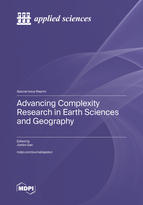Advancing Complexity Research in Earth Sciences and Geography
A special issue of Applied Sciences (ISSN 2076-3417). This special issue belongs to the section "Earth Sciences".
Deadline for manuscript submissions: closed (31 October 2023) | Viewed by 44259
Special Issue Editor
Interests: nonlinear dynamics; time series analysis; multiscale modeling; multiscale analysis of geophysical and geographic data; medical informatics; quantitative research on social, economic and financial complexity
Special Issue Information
Dear Colleagues,
Many complex phenomena in earth sciences and geography, including nonlinear fluid motions in the atmosphere, oceans, rivers, and lakes, coastal morphodynamics, volcanic and seismic activities, spatiotemporal dynamics of species, human movement trajectory, and city transportation dynamics, among many others, have played significant roles in the creation of complexity science, especially chaos theory and fractal geometry.With our increasing understanding of complex systems and availability of richer and more powerful methods for modeling complex systems, it is time to systematically examine the many complex phenomena in earth sciences and geography using state-of-the-art methods for modeling complex data. Undoubtedly, such efforts will invigorate research in earth sciences and geography and facilitate further development of complexity science. To help to achieve this goal, this Special Issue calls for papers that discuss which problems/phenomena in earth sciences and geography are complex, how they can be best solved/understood with which methods (or combination of methods) from complexity science, and whether new concepts and methods are needed to solve new problems that are closely related to the emergence of big data in earth sciences and geography. The topics of interest include but are not limited to:
- Applications of complexity science in earth, ecological, and environmental sciences and geography;
- Fractal and spatial–temporal long-range correlations;
- Spatiotemporal data analysis;
- Multiscale analysis;
- Anomaly detection and precursor recognition in data;
- Complexity and natural hazards;
- Synthesizing methods from complexity science with AI-based techniques;
- Emergent phenomena in earth sciences and geography, including emergent behaviors in technological innovations.
Prof. Jianbo Gao
Guest Editor
Manuscript Submission Information
Manuscripts should be submitted online at www.mdpi.com by registering and logging in to this website. Once you are registered, click here to go to the submission form. Manuscripts can be submitted until the deadline. All submissions that pass pre-check are peer-reviewed. Accepted papers will be published continuously in the journal (as soon as accepted) and will be listed together on the special issue website. Research articles, review articles as well as short communications are invited. For planned papers, a title and short abstract (about 100 words) can be sent to the Editorial Office for announcement on this website.
Submitted manuscripts should not have been published previously, nor be under consideration for publication elsewhere (except conference proceedings papers). All manuscripts are thoroughly refereed through a single-blind peer-review process. A guide for authors and other relevant information for submission of manuscripts is available on the Instructions for Authors page. Applied Sciences is an international peer-reviewed open access semimonthly journal published by MDPI.
Please visit the Instructions for Authors page before submitting a manuscript. The Article Processing Charge (APC) for publication in this open access journal is 2400 CHF (Swiss Francs). Submitted papers should be well formatted and use good English. Authors may use MDPI's English editing service prior to publication or during author revisions.
Keywords
- Complexity
- chaos
- fractal
- long-range correlation
- natural hazards
- emergence






